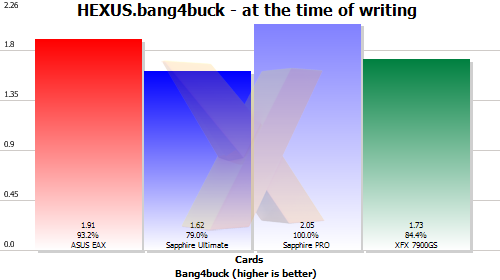Overclocking and HEXUS.bang4buck
Overclocking
To overclock the ASUS EAX1950Pro, we used ASUS' SmartDoctor software to control the fan speeds for better cooling. With the fan cranked right up to its maximum speed the card stopped being the gentle beast it once was and started to generate a loud and unpleasant whine.This, however, allowed us to increase the core clock from the 580.5MHz stock speed to 627MHz. We also managed to get the memory speed up from its default 1.404GHz to an impressive 1.647GHz. This resulted in an extra 4FPS in our Splinter Cell: Chaos Theory test, which takes in both a high resolution and HDR: The increase is manifested by a ~10% increase in framerate in that particular test.
The ASUS card will automatically overclock, but if you want to use those features you'll need to use ASUS' own "Enhanced Driver", which means you'll always be behind the curve as far as software updates go.
HEXUS.bang4buck
In a rough-and-ready assessment of the card's bang per buck, we've aggregated the average 1280x1024 4xAA 8xAF framerates for the three games, normalised them*, and listed the cards' price. There are more provisos than I care to shake a stick at. We could have chosen three different games, the cards' prices could have been derived from other sources and pricing is such that it can fluctuate daily. However, to reiterate, the graph below highlights a metric that should only be used as a yardstick for evaluating comparative performance with price factored in. Other architectural benefits are not covered, obviously.| Card | ASUS EAX1950PRO 256MB | Sapphire X1950 PRO Ultimate 256MB | Sapphire X1950 PRO 256MB | XFX Geforce 7900GS 256MB GDDR3 Extreme Edition |
|---|---|---|---|---|
| Aggregate marks at 1280x1024 4xAA 8xAF | 253.66 | 261.64 | 253.91 | 251.52 |
| Aggregate marks at 1280x1024 4xAA 8xAF, normalised | 216.65 | 220.6 | 217 | 215.75 |
| Price - at the time of writing | £113.26 | £136.26 | £105.62 | £125.00 |
| Acceptable framerate (60FPS average) at 1280x1024 4xAA 8xAF | Yes | Yes | Yes | No (SC) |
- The normalisation refers to taking playable framerates, which we consider to be an average of 60FPS in all games, into account. Should a card benchmark at over 60FPS in any one game, the extra FPS counts as half. Similarly, should a card benchmark lower, say at 40FPS, we deduct half the difference from its average framerate and the desired 60FPS, giving it a bang4buck score of 30 marks. The minimum framerate, then, can be 20FPS, as that will score 0.
As an example, should a card score 120FPS we count it as 90FPS (120 - (120-60)/2) as only half the framerate above 60FPS is counted for the bang4buck. Similarly, should it score 30FPS we count it as only 15FPS (30 + (30-60)/2).
The reasoning behind such calculation lies with playable framerates. Should card A score 110FPS in a benchmark and card B 160, then card B would normally receive an extra 50 marks in our bang4buck assessment, even though both cards produce perfectly playable framerates and anything above 60FPS is a bonus and not a necessity for most. However, the bang4buck total would be identical if in another benchmark card A scored a smooth 70FPS and card B an unplayable 20FPS, as both aggregate to 180 marks, yet the games-playing experience would be vastly different. You would, on balance, say that card A was better because it ran smoothly in both games. In our revised aggregation, card A would receive 150 marks (85 + 65) and card B 110 (110 + 0).
In effect, we're including a desired average framerate, in this case 60, and penalising lower performance whilst giving higher-than 60FPS framerates half as much credit as the framerate up to 60FPS. If that doesn't make sense or you have issue with it, please hit the HEXUS community.

The graph highlights the normalised marks divided by current price. The ASUS EAX1950PRO offers decent value for money when compared against the other three cards. As you can see, its performance is well-balanced against the initial outlay. Of course, this graph simply highlights performance and price. Non-3D-related features, such as the heatpipe cooler, aren't covered.









